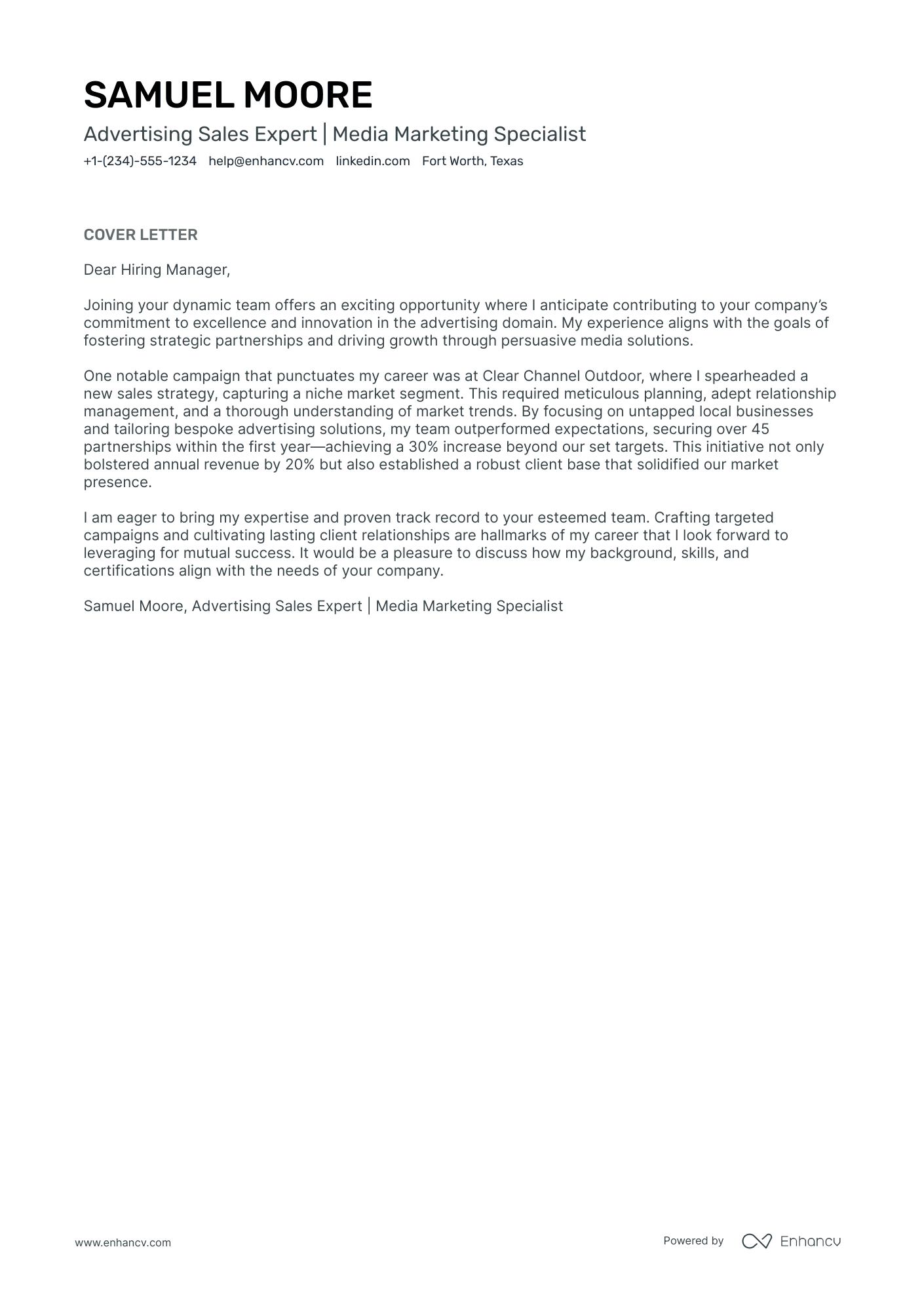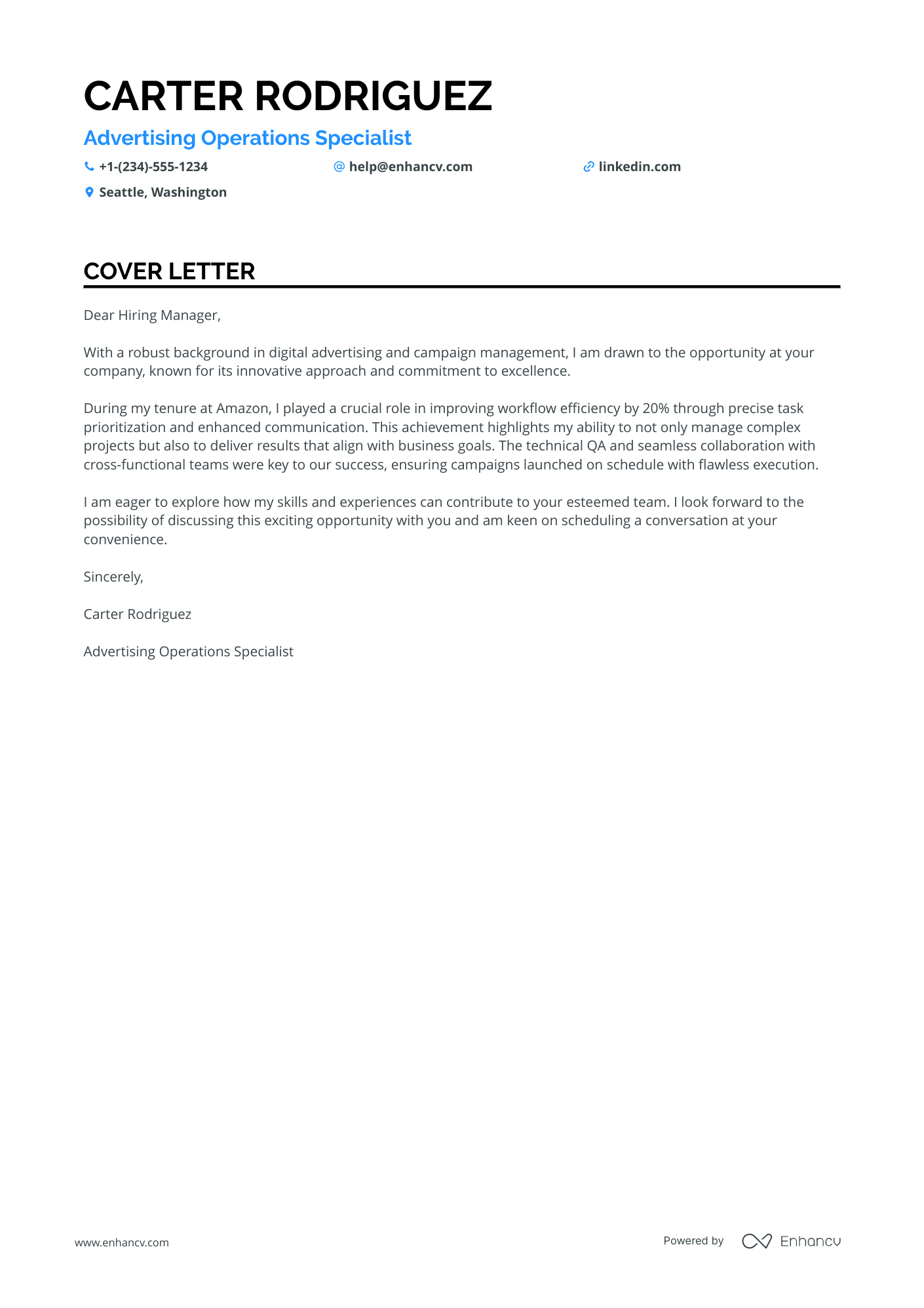Crafting an advertising cover letter can be a daunting task. You've been diligently applying for jobs, only to realize a persuasive cover letter is a must-have. It's not about echoing your resume; it's your chance to weave a compelling narrative around your proudest professional moment. Striking the right tone—formal yet original, avoiding worn-out phrases—is crucial. And remember, brevity is key: your powerful story should unfold on just one page.
- Personalize your advertising cover letter and get inspired by other professionals to tell a compelling story;
- Format and design your advertising cover letter to make an excellent first impression;
- Introduce your best achievement in your advertising cover letter to recruiters;
- How to make sure recruiters get in touch with you, using your advertising cover letter greeting and closing paragraphs.
What is more, did you know that Enhancv's AI can write your cover letter for you? Just upload your advertising resume and get ready to forward your job application in a flash.
If the advertising isn't exactly the one you're looking for we have a plethora of cover letter examples for jobs like this one:
- Advertising resume guide and example
- Fashion Marketing cover letter example
- Trade Marketing Manager cover letter example
- Brand Director cover letter example
- VP Digital Marketing cover letter example
- Creative Manager cover letter example
- Brand Manager cover letter example
- Event Marketing cover letter example
- Content Writer cover letter example
- Social Media Specialist cover letter example
- Assistant Brand Manager cover letter example
Drop your resume here or choose a file.
PDF & DOCX only. Max 2MB file size.
Advertising cover letter example
Ella Green
San Diego, California
+1-(234)-555-1234
help@enhancv.com
- Highlighting specific achievements (e.g., "resulting in a robust 40% increase in market share") demonstrates quantitative success and could be compelling for roles requiring someone who can deliver measurable results.
- Reference to navigating "complex FDA regulations" showcases expertise in a critical area for roles within pharmaceuticals or any other industry where regulatory compliance is a major concern, demonstrating both knowledge and experience that would be essential for such a position.
- Emphasizing cross-functional leadership and its impact on doctor-patient communication addresses the necessary soft skills and the ability to work in a team-oriented environment, which is crucial for a directorial role that collaborates with multiple departments.
The format of your advertising cover letter: structure, fonts, margins, and more
Your advertising cover letter should include a header (with your name, position, and date); a greeting and introductory paragraph; a body and closing paragraphs; and an optional signature.
Remember that you're writing your advertising cover letter for recruiters - as the Applicant Tracker System won't scan this content.
Here are a few more tips and tricks to keep in mind when formatting your advertising cover letter:
- Use the same font in your advertising cover letter and resume. We recommend modern fonts, e.g. Lato and Rubik, to help you stand out, instead of the stereotypical Arial and Times New Roman.
- Each paragraph should have single spacing, which is already set up for you in our cover letter templates.
- Our cover letter builder follows industry standards for your advertising cover letter formatting - with a one-inch margin, surrounding your content.
- Always export your advertising cover letter in PDF to ensure the image or text quality stays the same and your writing isn't moved about.
Skip the hassle of writing a cover letter. Use our free cover letter generator and get it done in moments.
The top sections on a advertising cover letter
- Header: Include your contact information and the date, ensuring the recruiter can easily identify who you are and how to reach you.
- Greeting: Use a personalized salutation to address the hiring manager by name, demonstrating your attention to detail and your interest in the company.
- Introduction: Start with a compelling opening that highlights your enthusiasm for advertising and your understanding of the company's brand or notable campaigns to engage the reader immediately.
- Body: Detail your experience with successful advertising campaigns, your creative process, and familiarity with different media platforms, showing your ability to contribute to the business's advertising goals.
- Closing: Finish with a strong call-to-action, expressing your desire to discuss how your advertising skills and experiences align with the company's needs, and thank them for considering your application.
Key qualities recruiters search for in a candidate’s cover letter
Creativity and Innovation: Crucial for designing unique and effective advertising campaigns that capture attention and differentiate clients in the market.
Strong Copywriting Skills: Essential for crafting compelling messages and calls-to-action that resonate with target audiences and drive results.
Data Analysis and Metrics Interpretation: Valuable for understanding campaign performance, optimizing strategy, and demonstrating ROI to clients.
Technological Proficiency: Important for leveraging the latest digital platforms, tools, and trends to create and track cutting-edge campaigns.
Understanding of Consumer Psychology: Helps in creating advertisements that tap into the emotions and behaviors of the target audience, increasing engagement and effectiveness.
Excellent Communication and Team Collaboration: A must for effectively pitching ideas, working with diverse teams, and managing client relationships throughout the campaign lifecycle.
How to greet recruiters in your advertising cover letter salutation
As the saying goes, "You never get a second chance to make a first impression."
Write your advertising cover letter salutation to be more personalized to the actual hiring manager, who is set to assess your profile by:
- greeting them on a first-name basis, if you have previously communicated with them (e.g. "Dear Sam,");
- using their last name, if you have more formal communication or haven't spoken to them (e.g. "Dear Mr. Harrows" or "Dear Ms. Marshall");
- writing "Dear HR Team" or "Dear Hiring Manager", if you have no clue about who's recruiting for the role.
Search on LinkedIn, Google, or the company website to find information as to the recruiter's name.
In any case, avoid the impersonal "Dear Sir or Madam".
List of salutations you can use
- Dear Hiring Manager,
- Dear [Department] Team,
- Dear Ms. [Last Name],
- Dear Mr. [Last Name],
- Dear Dr. [Last Name],
- Dear [First Name] [Last Name],
How to start your advertising cover letter introduction
The opening paragraph of your advertising cover letter can seem like a real enigma.
Where do you start writing?
In your advertising cover letter introduction, focus on yourself by stating what:
- gets you motivated and excited about the role;
- you like best about the company, from culture to awards.
Write no more than two sentences, which are both authentic and show your enthusiasm for the opportunity.
What comes next: your advertising cover letter middle paragraphs
In the next three to six paragraphs (or the body of your advertising cover letter) you have to prove your unique value.
Most candidates tend to mess up at this stage. They tend to just copy-paste information from their resume.
That's one big no-no.
Remember that when writing your advertising cover letter, it has to be personalized. And, your ultimate aim is to catch the recruiter's eye.
So, look back on key job requirements and write down a list that includes the ones you cover.
Next, select just one key achievement from your professional (or personal) history that meets those advert keywords.
Narrate a story around how you've grown your skill set and knowledge. Also, aim to show the unique understanding or soft skills you bring about, thanks to your past success.
Two ideas on how to end the final paragraph of your advertising cover letter
Closing your advertising cover letter, you want to leave a memorable impression on recruiters, that you're a responsible professional.
End your cover letter with how you envision your growth, as part of the company. Make realistic promises on what you plan to achieve, potentially, in the next six months to a year.
Before your signature, you could also signal hiring managers that you're available for the next steps. Or, a follow-up call, during which you could further clarify your experience or professional value.
Addressing limited to no experience in the advertising cover letter
There's nothing to worry about if you lack professional experience.
Your advertising cover letter could bridge the gaps in your professional history by focusing on what matters most to recruiters, that's either:
- skills - focusing on transferable ones you've gained, thanks to your life experience (e.g. volunteering, certificates, etc.);
- achievements - select the most relevant and noteworthy one from your history (e.g. education, projects, etc.);
- motivation - describe how you envision your professional growth in the next up to five years, thanks to this opportunity.
Key takeaways
Writing your advertising cover letter doesn't need to turn into an endless quest, but instead:
- Create an individual advertising cover letter for each role you apply to, based on job criteria (use our builder to transform your resume into a cover letter, which you could edit to match the job);
- Stick with the same font you've used in your resume (e.g. Raleway) and ensure your advertising cover letter is single-spaced and has a one-inch margin all around;
- Introduce your enthusiasm for the role or the company at the beginning of your advertising cover letter to make a good first impression;
- Align what matters most to the company by selecting just one achievement from your experience, that has taught you valuable skills and knowledge for the job;
- End your advertising cover letter like any good story - with a promise for greatness or follow-up for an interview.
Advertising cover letter examples
By Role
Digital Advertising
Online Advertising
Advertising Sales
Advertising Operations Specialist
- Emphasizing relevant experience: The cover letter highlights the candidate's tenure at Amazon, illustrating experience directly related to digital advertising and campaign management.
- Quantifying achievements: Mentioning a 20% improvement in workflow efficiency provides a concrete measure of success, showing the candidate's impact in previous roles.
- Showcasing problem-solving abilities: Discussing the enhancement of task prioritization and communication skills demonstrates the candidate's ability to tackle challenges effectively.
- Expressing enthusiasm and alignment with company values: The candidate shows interest in the company's innovative approach and commitment to excellence, indicating a good cultural fit.













